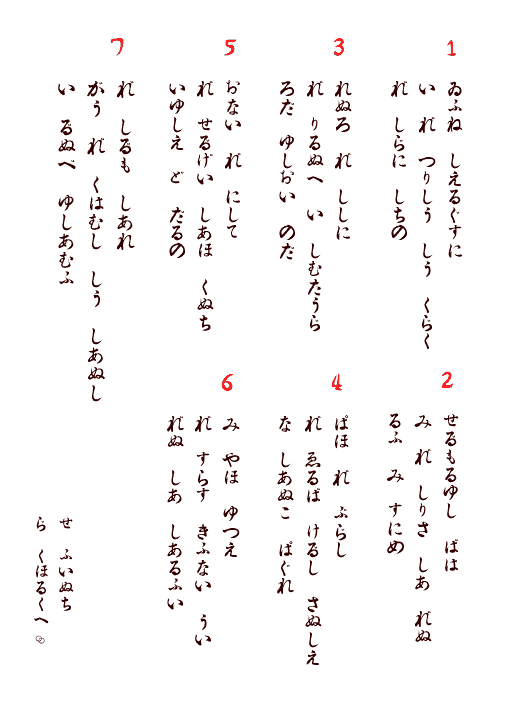hiragana
Jump to navigation
Jump to search
| The formatting of this page has been checked for following the guidelines of le uitki. |
- .aulun.:
- Here I've created a Hiragana chart in order to get an idea how to maybe adapt this syllabic alphabet to Lojban and also to stir up your own creativity! Any suggestions appreciated.

- Like Latin or Greek in the Western world, in Japan scholarly topics initially were written in Chinese language. Later, Japanese language was written using Chinese characters to indicate Japanese syllables (Manyogana, from "10000 Leaves Anthology" - Manyoshu).
- In about 8th - 9th century, the very pleasant cursive Hiragana syllabic script was developed from highly sophisticated Chinese "cao shu" style ("grass" or draft style[1]). Hiragana script was preferred for Japanese poetic calligraphy mainly done by females. In modern Japanese, Hiragana is used to add suffixes etc. to the (Chinese) Kana "symbol" characters (Kanji - Hanzi).
- About in the 12th century, a more simplified syllabic version was created, called "Katakana", which today is used mainly to express foreign words (e.g. proper names like "Siemens","General Motors" etc.).
Technical Issues With Alternate Orthographies.
A simple SILKey program for syllabic input and it works (without essential bugs). Here is a sample of xorxes' haikus:

It's still not too elaborated, yet, for Lojban (didn't alter the characters' shapes). Just some initial ideas:
- The consonant "R" is equal to "L" (could be altered by adding a "nigori" to "R")
- Syllables with final "-u" can (also) stand for consonants.
- Syllables with final "-i" can (also) stand for consonants (priority "-u").
- "sh" - like in cu is built by "shi-vowel" (e.g. shi-u).
- "f" - like in fe - is built by "fu-vowel" or "fu+h-vowel" (e.g. fu-e or fu-he).
- "v-vowel" is "w-vowel"
- j (e.g. ja) is problematic: tried it as "zu+shi+vowel" (e.g. "zu+shi+a)
- x (e.g. xorxes) is problematic: tried it as "ku+h-vowel" (e.g. "ku+ho)
- consonant finals (in cmene) are indicated by a dot (=circle)
You see: neither hiragana nor katakana is too good an idea for Lojban transcription (yet, it looks nice, doesn't it?)
BTW, here's my site for Lojban-Hiragana and here a humble try on The Year 2001 - Sept. 11
Discussion
- Juuitchan:
- Please remember that the Japanese have kana (think you're referring to hiragana syllables rather than to Chinese characters) combinations you missed.
- sha = shi + small ya ....
- shu = shi + small yu ....
- she = shi + small e ....
- sho = shi + small yo ....
- ji = shi with nigori ....
- ja, ju, je, jo are made in the same manner as sha, shu, she, sho, but with ji in place of shi.
- Please remember that the Japanese have kana (think you're referring to hiragana syllables rather than to Chinese characters) combinations you missed.